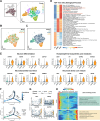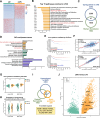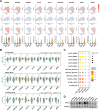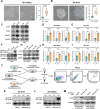SLIT3-mediated intratumoral crosstalk induces neuroblastoma differentiation via a spontaneous regression-like program
- PMID: 40448172
- PMCID: PMC12123822
- DOI: 10.1186/s12967-025-06621-0
SLIT3-mediated intratumoral crosstalk induces neuroblastoma differentiation via a spontaneous regression-like program
Abstract
Background: Neuroblastoma, the most common pediatric extracranial solid tumor, has heterogeneous clinical outcomes ranging from malignant progression to spontaneous regression. With the highest frequency of the elusive spontaneous regression, low-risk INSS Stage 4S neuroblastoma represents an ideal model for mechanistic investigation. Spontaneous regression is often accompanied by tumor differentiation, but the mechanisms underlying this process remain largely unclear.
Methods: Single-nucleus transcriptomics (snRNA-seq) data of neuroblastoma samples were obtained from the Synapse repository to investigate the composition of heterogeneous tumor cell clusters. The feature of the Stage 4S-specific tumor cell subpopulation was revealed through differential expression analysis, pathway enrichment analysis and pseudotime analysis, followed by clinical significance validation on public cohort datasets. The biological function of secreted SLIT3 was validated using multiple in vitro models, including recombinant protein treatment, conditioned medium treatment, and cell lines coculture, to confirm the intratumoral crosstalk effect. Orthotopic and subcutaneous xenograft models were established to verify SLIT3's in vivo function. Cellular bulk RNA-seq analysis was performed with or without SLIT3 recombinant protein treatment to discover the downstream pathways activated by SLIT3, followed by validation with specific pathway inhibitors.
Results: Analysis of snRNA-seq revealed a distinct subpopulation of tumor cells within INSS Stage 4S neuroblastoma, characterized by a spontaneous regression-like program progressing toward differentiation. Activated SLIT-ROBO signaling was found in the Stage 4S-specific tumor cell subpopulation, which strongly correlated with favorable prognosis. Further investigation into the secreted ligands in SLIT-ROBO related pathways revealed that SLIT3 displayed the most potent enrichment in Stage 4S tumors and the strongest differentiation-inducing effect. In vitro experiments using recombinant SLIT3 protein, conditioned medium, and cell lines coculture consistently demonstrated the capacity of SLIT3 to induce neuroblastoma cell differentiation via intratumoral crosstalk, as evidenced by increased neurite outgrowth and elevated expression of neuronal differentiation markers. Both orthotopic xenograft and subcutaneous xenograft models demonstrated that SLIT3 expression suppressed tumor growth, leading to in vivo tumor differentiation. Mechanistically, PLCβ/PKC signaling mediates the SLIT3-induced neuroblastoma cell differentiation.
Conclusions: Stage 4S-specific tumor cell subpopulation exhibits a spontaneous regression-like program, from which SLIT3 mediates intratumoral crosstalk and promotes neuroblastoma differentiation via PLCβ/PKC signaling. These findings provide new insights into the mechanism of spontaneous regression in neuroblastoma and offer novel therapeutic targets for differentiation-based treatment strategies.
Keywords: Differentiation induction therapy; Intra-tumor cell heterogeneity; Neuroblastoma; SLIT-ROBO signaling; SLIT3.
© 2025. The Author(s).
Conflict of interest statement
Declarations. Ethics approval and consent to participate: The studies involving patient information were reviewed and approved by Ethic Committee of Sun Yat-Sen University Cancer Center. All mouse experiments were approved by the Institutional Animal Care and Use Committee of Sun Yat-sen University Cancer Center. The animal experiments were carried out according to the 3Rs principle. Consent for publication: All authors consented to the submission and publication of this study. Competing interests: The authors declare no competing interests.
Figures







Similar articles
-
Hox-C9 activates the intrinsic pathway of apoptosis and is associated with spontaneous regression in neuroblastoma.Cell Death Dis. 2013 Apr 11;4(4):e586. doi: 10.1038/cddis.2013.84. Cell Death Dis. 2013. PMID: 23579273 Free PMC article.
-
Anlotinib induces neuronal-like differentiation of neuroblastoma by downregulating CRMP5.Mol Carcinog. 2024 Aug;63(8):1559-1571. doi: 10.1002/mc.23745. Epub 2024 May 23. Mol Carcinog. 2024. PMID: 38780126
-
Inhibition of Purine Metabolism Promotes the Differentiation of Neuroblastoma Driven by MYCN.Cancer Med. 2025 May;14(9):e70953. doi: 10.1002/cam4.70953. Cancer Med. 2025. PMID: 40353332 Free PMC article.
-
Why does stage 4s neuroblastoma regress spontaneously?Lancet. 1994 Sep 24;344(8926):869-70. doi: 10.1016/s0140-6736(94)92834-7. Lancet. 1994. PMID: 7916408 Review. No abstract available.
-
Spontaneous regression of neuroblastoma.Cell Tissue Res. 2018 May;372(2):277-286. doi: 10.1007/s00441-017-2761-2. Epub 2018 Jan 5. Cell Tissue Res. 2018. PMID: 29305654 Free PMC article. Review.
References
-
- Sharma R, Yadav J, Bhat SA, Musayev A, Myrzagulova S, Sharma D, et al. Emerging trends in neuroblastoma diagnosis, therapeutics, and research. Mol Neurobiol. 2025;62:6423–66. - PubMed
-
- Li J, Thompson TD, Miller JW, Pollack LA, Stewart SL. Cancer incidence among children and adolescents in the united states, 2001–2003. Pediatrics. 2008;121:e1470–7. - PubMed
-
- Brodeur GM, Pritchard J, Berthold F, Carlsen NL, Castel V, Castelberry RP, et al. Revisions of the international criteria for neuroblastoma diagnosis, staging, and response to treatment. J Clin Oncol. 1993;11:1466–77. - PubMed
-
- Levitt G, Platt K, De Byrne R, Sebire N, Owens C. S neuroblastoma: the long-term outcome. Pediatr Blood Cancer. 2004;43:120–5. - PubMed
MeSH terms
Substances
Grants and funding
LinkOut - more resources
Full Text Sources
Medical

